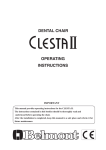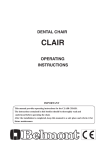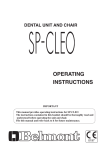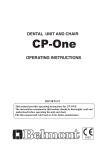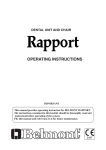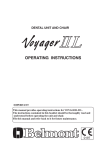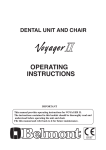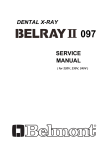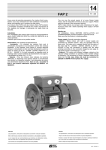Download Operating Instructions DENTAL LIGHT
Transcript
DENTAL LIGHT 048 Operating Instructions IMPORTANT After installation is completed, check all the bolts, screws and fasteners to confirm that they are securely fastened. TABLE OF CONTENTS [1] SPECIFICATIONS.............................................................. 1 [2] CLASSIFICATION............................................................. 1 [3] OPERATING INSTRUCTION........................................... 1 [4] ADJUSMENT COMPONENTS......................................... 2 [5] HALOGEN BULB CHANGING........................................ 2 [6] MAINTENANCE INFORMATION................................... 3 [7] MAINTENANCE AND INSPECTION.............................. 4 [8] BEFORE ASKING FOR REPAIRS.................................... 5 [9] ELECTROMAGNETIC COMPATIBILITY(EMC)........... 6 Intended Use of the Product This product is intended for the exclusive use for diagnoses, treatments and relative procedures of dentistry, and must be operated or handled by the qualified dentists or by dental staffs under the supervision of the dentist. Such dentists or dental staffs should instruct and/or assist the patients to approach to and leave from the product. Patients should not be allowed to operate or handle the product unless he/she is so instructed. Environmental condition for Operation Temperature : 5 ~ 40℃ Humidity : 10 ~ 80% Pressure : 600 ~ 1060 hpa Environmental condition for Storage Temperature : -10 ~ 50℃ Humidity : 10 ~ 80% Pressure : 600 ~ 1060 hpa Environmental condition for Transportation Temperature : -10 ~ 50℃ Humidity : 10 ~ 80% Pressure : 600 ~ 1060 hpa Important Notes In case of the troubles, please contat Takara Belmont offices or your dealers. Do not disassemble or attempt to repair. Disassembly, repair or modifications should only be done by a qualified repair technician. Attempts at disassembly, repair or modifications may lead to abnormal operation and accidents. –– In case of disposal of equipment When disposing the dental light, appropriately dispose complying with all current applicable regulations and local codes. In EU area, EU directive 2002/96/EC on waste electrical and electronic equipment (WEEE) is applied on this product. In this directive, environment conscious recycling/abandonment is obligated. Symbols Alternating-current 㻨㻦 㻵㻨㻳 Authorized representative in the European community Separate collection for electrical and electronic equipment Power OFF Power ON Date of manufacture Manufacturer Non-ionizing radiation Caution It means “caution, warnings, or possibility to danger”. Refer to instruction manual/booklet WARNING Operation of a dental light under Electro Magnetic Interferences. This equipment may malfunction by electromagnetic interferences. Do not install dental light close to the equipment that generates electromagnetic interference (i.e. communication equipment, elevator) Do not use the device that creates interference (i.e. cellular phone) near this equipment. Do not use electric surgical knife or laser knife with dental light. Light may turns on/off by itself due to malfunction of a sensor caused by electromagnetic interferences. WARNING • To avoid the risk of electric shock, this equipment must only be connected to supply mains with protective earth. • Lamp bulb cover becomes very hot during use.To avoid burning fingers, do not a touch lamp cover. • Always put a lamp cover on to avoid burning fingers. • Position a light head by holding light handle(s). • Installation and service work should be conducted by an authorized installation/service personnel only. WARNING: The followings are prohibited. • To modify this equipment. • To use the equipment under any failure condition. • To use the equipment without doing the daily and periodical check-up. • To wipe the plastic covers with any disinfectant or detergent that contains organic solvent. –– Precautions for Installation • Keep the equipment away from water. • Keep in circumstances safe from influence by temperature, humidity, wind, sun light, air containing salts and minerals. • Care about stability such as inclination, vibration and impact, including handling and transportation. • Do not keep the equipment in a place where chemicals are or where gas is emitted. • During lifting and unpacking of the light, make sure to hold only the designated parts. • Do not drop or hit the light. • Ground light properly prior to turning power on. • When the installation process has been completed, verify that all the mechanical and electrical functions are working properly. • Thick gloves are highly recommended at unpacking. • Do not modify this equipment. CAUTION Before use • Check connection of switches and make sure that the device functions properly. • Make sure that grounding wire is connected. • Make sure that cables are properly and perfectly connected. During use • Do not use the light longer than required for examination or treatment. • Always watch the patient and the equipment to make sure nothing is wrong. • If anything wrong is observed with the equipment or the patient, take a proper action, such as stopping the use of equipment as well as keeping the patient in safe. • Keep an eye on the patient not to touch the equipment. After use • Turn off the light. • Clean the equipment and get it ready for use. CAUTION Do not spray liquids directly onto light surfaces. In order to prevent damage to electrical components and systems, do not apply excess cleaning solution onto light surfaces. NOTE Warranty does not cover damage to equipment caused by disinfectant solutions Replacement of parts (Except the Bulb and Lamp cover) Replacement must be done by an professional technician(s) of our company or a company authorized by us. –– [1] SPECIFICATIONS Light Output.......................28,000 Lux High 18,000 Lux Low Color Temperature.............3,700 Kelvin High 3,600 Kelvin Low Light Pattern.......................200 x 80 at 725mm Service Life........................10 years Rated Voltage.....................AC230V 50/60Hz Fuse....................................1A/250V(Current Rating: 35A at 250VAC)Time-lag Output Voltage...................12V High, 10.5V Low Power Output.....................55W High, 42W Low Bulb Type...........................Tungsten Halogen Type JA 12V-55W Focal Distance....................725mm DICHROIC REFLECTOR The Dichroic Reflector allows heat (infrared) VISIBLE LIGHT HEAT (INFRARED) and ultraviolet to pass harmlessly through the back of the lamp housing. Only white light is GLARE STOP QUARTZ HALOGEN LAMP focused on the patient for reduced eyestrain and comfort. ULTRAVIOLET REFLECTOR The Belmont lights incorporate the latest advances in dental lighting technology. The light is color matched to natural daylight, is easily cleaned, has a dual intensity on-off control and smooth easy positioning. [2] CLASSIFICATION a. Protection against electric shock : Class I Equipment. b. Equipment not suitable for use in the presence of a flammable anesthetic mixture with air or with oxygen or nitrous oxide. [3] OPERATING INSTRUCTIONS Swivel Arm 3-1. Major Parts Identification Transformer Housing Assembly Balance Arm Assembly Head Angle Adjustment Tension Adjustment Adjstment Tool Head Assembly 3-2. Dual Intensity ON/OFF Switch 1. High Beam; push toggle to left 2. Low beam; push toggle to right Switch is conveniently located in light head enabling intensity to be changed from seated position. Low intensity - for longer bulb life and examining facial surfaces. High intensity - for color matching and examining lingual surfaces. –– -1A- -1- Mode Selection Switch HIGH LOW [4] ADJUSTMENT COMPONENTS 4-1. Balance Arm Adjustment. (Should drifting occur) IMPORTANT; Use slot closest to head when making adjustment for drifting of balance arm. Insert adjusting bar into slot on top of balance arm, turn spring adjustment nut clockwise for more tension; counterclockwise for less tension. Adjusting Bar Left Right 4-2. Head Angle Adjustment. IMPORTANT; Use slot closest to swing arm (H-shaped casting bracket) when adjusting angle of head. Insert adjusting bar into slot on top of balance arm, turn head angle adjustment nut clockwise for downward angle; counterclockwise for upward angle. Head Adjusting Bar Swing Arm *Adjusting bar is supplied in envelope with allen wrenches. Left Right Upward angle when turning adjustment nut clockwise Downward angle when turning adjustment nut counter-clockwise [5] Halogen Bulb Changing 5-1. Halogen Bulb Changing CAUTION Halogen bulb and sorrounding parts may be hot immediately after the lamp goes off. Wait unit they get cool down. IMPORTANT; Do not touch glass with bare hand. Halogen bulb surface must be clean. Oil or body moisture will affect bulb span of life. If glass surface is touched, clean with alcohol. 1. To install replacement halogen bulb, turn light off and remove back cover, by loosening stopper screw. 2. Push in spring clip and turn it counterclockwise to remove spring clip. 3. Pull off halogen bulb from lamp socket. Disconnect lead wire when bulb is completely removed. 4. Replace new Halogen bulb into the lamp socket, and connect lead wire. 5. After new bulb is seated in housing, insert and lock spring clip into position. 6. Reattach back cover. –– --22- Halogen Bulb Spring Clip Back Cover Dual Intensity On/Off Switch Lead Wire Stopper Screw [6] Maintenance Information 6-1. Cleaning Allow light to cool prior to cleaning. Use only soft cloth to prevent surfaces from being scratched. Cloth may be moistened with ethanol. REFLECTOR : Extreme care should be taken to prevent scratching reflector surfaces, as this will degrade the performance of the light. 6-2. Lubrication A drop of oil once a year at each pivot point will provide ample lubrication. –– --33- [7] MAINTENANCE AND INSPECTION 7-1.Guide for daily maintenance and inspection (Maintenance and inspection by user) Management of maintenance and inspection of medical equipment should be implemented by the user (medical inspection). In case the user does not implement such management, it is permitted that such management is outsourced to a qualified entity such as a medical equipment repair company. For safe use of this product, it is necessary that inspection should be conducted in the specified frequency on the items described below. No. Item Frequency Inspection Method and diagnosis Influence if inspection is not conducted Maintenance required in case of nonconformity 1 Appearance of Lamp Cover Before start Check deformation, scratches by eyes Deterioration of optical performance 2 Lamp cover is firmly attached or not Before start Pull the lamp cover. Make sure that the Mirror cover doesn't fall Lamp cover may fall. Reattach a Lamp cover 3 Light bulb Before start Check whether the light brinks or not due to the poor connection. Light bulb turns very hot. This could shorten bulb life. Securely insert a light bulb into the bulb holder 4 Light switch Before start Confirms the light turns on. Light doesn't function. Replace a light bulb 5 Functionality of Balance Arm Before start Swing the balance arm up/down. Swing the balance arm right/left. Make sure the balance arm stops and holds its position. Light head doesn't stay at the desired position. 6 Vertical rotation of the Light head Before start Rotate the light head up/down. Make sure the light head stops and holds its position. Light head doesn't stay at the desired position. 7 Light head angle Before start Confirms the light head is vertically aligned. Light head doesn't stay at the desired position. Adjust the angle of the light head. 8 Light head rotation Before start Rotate the light head right/left. Make sure the light rotate 160° to each direction. Light head rotates freely. This may cause the snapping of a wire. Contact your dealer or our office 9 Movement of the trolly (Track light) Before start Check the movement of the trolly. Make sure the trolly run smoothly. Light head doesn't stay at the desired position. Contact your dealer or our office. Track section (Track light) Before start Make sure that no wobble the track section when the product is operated. There is a possibility that the light falls. Contact your dealer or our office. Discoloration and deterioration to the exterior, and corrosion and rusting to metallic components may arise. Executes wiping in accordance with "Cleaning Instructions" Light may not function right. Turn off the light.Contact your dealer or our office 10 11 Care exterior Before start Chemical and dirt on the product exterior must be cleaned. 12 Other 1 Once every week Make sure that no abnormal noise occurs when the product is operated. 13 Other 2 㻃As needed If the light has not been used for a long time, make sure the light functions correctly and safely. –– -4- Change a lamp cover Adjust the tension of the balance arm. Adjust the tension of vertical rotation. If the light malfunctions, Contact your dealer or our office 7-2. Guide for Periodical Check-up Some parts and components of the products are degraded or deteriorated depending on the frequency of use. Annual check-up and maintenance, as well as replacement of consumable parts, are required. The required parts (including consumable parts) are listed below. It may be different from the following list depending on the option of the light. For check-up and repair, call a technician of our authorized dealer. Parts and components that require periodical check-up Standard Lifetime No. Moving part 7 years 3 Electric wiring of moving part 5 years No. Parts Description 1 2 Parts Description Switches Standard Lifetime 5 years Consumable parts No . Parts Description 1 Bulb 2 Lamp Cover 3 Fuse WARNING Execute the maintenance in accordance with this instraction manual and operating manual attached to each individual equipment ( Dental unit, Handpiece, etc..) . Failure to maintain this product may lead to physical injury or property damage. [8] BEFORE ASKING FOR REPAIRS If any of phenomena described below has occurred, make the following checks before asking for repairs. Phenomenon Check point and result Action to be taken The light does not light up. Unit main switch is not on. Turn on the unit main switch. Dental light switch is not on. Turn on the dental light switch to high or low side. Light bulb had been burned out. Replace with a new light bulb. Refer to halogen bulb changing section in this manual. Wrong light bulb is used. Use specifed light bulb described in specification section in this manual. If the dental light does not normally work even if actions were taken upon checkup stated above, then stop using the unit, turn off the main switch and contact your dealer or our office. –– -5- [9] ELECTROMAGNETIC COMPATIBILITY(EMC) Medical electrical equipment needs special precautions regarding EMC and needs to be installed and put into service according to the EMC information provided in this manual. Portable and mobile RF communications equipment can affect medical electrical equipment. The equipment or system should not be used adjacent to or stacked with other equipment. If adjacent or stacked use is necessary, the equipment or system should be observed to verify normal operation in the configuration in which it will be used. Guidance and manufacture’s declaration - electromagnetic emissions The 048 is intended for use in the electromagnetic environment specified below. The customer or the user of the 048 should assure that it is used in such an environment. Emissions test Compliance Electromagnetic environment - guidance RF emissions The 048 uses RF energy only for its internal function. CISPR 11 Group 1 Therefore, its RF emissions are very low and are not likely to cause any interference in nearby electronic equipment. RF emissions The 048 is suitable for use in all establishments, including Class B CISPR 11 domestic establishments and those directly connected to Harmonic emissions the public low-voltage power supply network that supplies Class A IEC 61000-3-2 buildings used for domestic purposes. Voltage fluctuations/ Flicker emissions Complies IEC 61000-3-3 Guidance and manufacture’s declaration - electromagnetic immunity The 048 is intended for use in the electromagnetic environment specified below. The customer or the user of the 048 should assure that it is used in such an environment. IEC 60601 Electromagnetic environment Immunity test Compliance level test level guidance Electrostatic Floors should be wood, concrete or ± 6 kV contact ± 6 kV contact discharge (ESD) ceramic file. If floors are covered ± 8 kV air ± 8 kV air IEC 61000-4-2 with synthetic material, the relative humidity should be at least 30%. Electrical fast Mains power quality should be that ± 2 kV for power ± 2 kV for power transient/burst supply lines supply lines of a typical commercial or hospital IEC 61000-4-4 environment. ± 1 kV for input/output ± 1 kV for input/output lines lines Surge ± 1 kV differential mode ± 1 kV differential mode Mains power quality should be that IEC 61000-4-5 of a typical commercial or hospital ± 2 kV common mode ± 2 kV common mode environment. Voltage dips, short <5% UT <5% UT Mains power quality should be that interruptions and (>95% dip in UT) (>95% dip in UT) of a typical commercial or hospital voltage variations for 0.5 cycle for 0.5 cycle environment. If the user of the on power supply 40% UT 40% UT 048 requires continued operation input lines (60% dip in UT) (60% dip in UT) during power mains interruptions, IEC 61000-4-11 for 5 cycle for 5 cycle it is recommended that the 048 be 70% UT 70% UT powered from an uninterruptible (30% dip in UT) (30% dip in UT) power supply or a battery. for 25cycle for 25cycle <5% UT <5% UT (>95% dip in UT) (>95% dip in UT) for 5 s for 5 s Power frequency 3 A/m 3 A/m Power frequency magnetic fields (50/60 Hz) should be at levels characteristic magnetic field of a typical location in a typical IEC 61000-4-8 commercial or hospital environment. NOTE UT is the a.c. mains voltage prior to applications of the test level. – 10 – --46- Guidance and manufacture’s declaration – electromagnetic immunity The 048 is intended for use in the electromagnetic environment specified below. The customer or the user of the 048 should assure that it is used in such an environment. Compliance Immunity test IEC 60601 test level Electromagnetic environment - guidance level Portable and mobile RF communications equipment should be used no closer to any part of the 048, including cables, than the recommended separation distance calculated from the equation applications to the Frequency of the transmitter. Conducted RF IEC 61000-4-6 3 Vrms 150 kHz to 80 MHz outside ISM bandsa 3 Vrms Radiated RF IEC 61000-4-3 3V/m 80 MHz to 2.5 GHz 3 V/m Recommended separation distance d = 1.2 √P d = 1.2 √P 80 MHz to 800 MHz d = 2.3 √P 800 MHz to 2.5 GHz Where P is the maximum output power rating of the transmitter in watts (W) according to the transmitter manufacturer and d is the recommended separation distance in metres (m). Field strengths from fixed RF transmitters, as determined by an electromagnetic site survey,a should be less than the compliance level in each frequency range.b Interference may occur in the vicinity of equipment marked with the following symbol: NOTE 1 At 80 MHz and 800MHz, the higher frequency range applies. NOTE 2 These guidelines may not apply in all situations. Electromagnetic propagation is affected by adsorption and reflection from structures, objects and people. a Field strengths from fixed transmitters, such as base stations for radio (cellular/cordless) telephones and land mobile radios, amateur radio, AM and FM radio broadcast and TV broadcast cannot be predicted theoretically with accuracy. To assess the electromagnetic environment due to fixed RF transmitters, an electromagnetic site survey should be considered. If the measured field strength in the location in which the 048 is used exceeds the applicable RF compliance level above, the 048 should be observed to verify normal operation. If abnormal performance is observed, additional measures may be necessary, such as reorienting or relocating the 048. b Over the frequency range 150 kHz to 80 MHz, field strengths should be less than 3V/m. Essential performance (purpose of IMMUNITY testing) There is no essential performance. – 11 – --5A7- Recommended separation distances between Portable and mobile RF communications equipment and the 048 The 048 is intended for use in an electromagnetic environment in which radiated RF disturbances are controlled. The customer or the user of the 048 can help prevent electromagnetic interference by maintaining a minimum distance between portable and mobile RF communications equipment (transmitters) and the 048 as recommended below, according to the maximum output power of the communications equipment. Separation distance according to frequency of transmitter Rated maximum output power m of transmitter 150 kHz to 80 MHz 80 MHz to 800 MHz 800 MHz to 2.5 GHz W d = 1.2 √P d = 1.2 √P d = 2.3 √P 0.01 0.12 0.12 0.23 0.1 0.38 0.38 0.73 1 1.2 1.2 2.3 10 3.8 3.8 7.3 100 12 12 23 For transmitters rated at a maximum output power not listed above, the recommended separation distance d in metres (m) can be estimated using the equation applicable to the frequency of the transmitter, where P is the maximum output power rating of the transmitter in watts (W) according to the transmitter manufacturer. NOTE 1 At 80 MHz and 800MHz, the separation distance for the higher frequency range applies. NOTE 2 These guidelines may not apply in all situations. Electromagnetic propagation is affected by adsorption and reflection from structures, objects and people. Takara Belmont (UK) Ltd. Bemont House TAKARA BELMONT CORPORATION One St.Andrews Way, Bow, 2-1-1, Higashishinsaibashi,Chuo-ku, Osaka, 542-0083, Japan London E3 3PA U.K. TEL : 81-6-6213-5945 FAX : 81-6-6212-3680 Tel : (44) 20-7515-0333 Fax : (44) 20-7987-3596 Book No. CASN65H0 Printed in Japan 2012.04 – 12 – -8-












